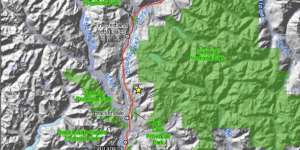

Introduction
The Garibaldi project at Squamish is a proposed destination mountain resort. In 2010, the BC Environmental Assessment Office stated that the project lacked information on underlying impacts on vegetation, fish and wildlife habitat. In 2015, the Resort Municipality of Whistler submitted a letter opposing the project, and they cited a 1974 report stating that “climatological considerations rule out reliable skiing on the lower 555m of vertical” . This lab produces maps of the area of this contentious development project and make interpretations on it. The methodology used to map includes acquiring, parsing, filtering, mining and representing data. The results demonstrate that the project would not be approved due to the lack of protection for old growth forest, ungulate and fish habitat and the unreliable areas for skiing below 555m. It is suggested that the project proponents could address the issues by marking these areas and setting up environmentally sensitive borders; whereas, the project would not be either environmentally or economically viable.
Methods
Before producing the map, I downloaded relevant data such as provincial-wide dataset called “Ungulate Winter Range - Approved” and “Old Growth Management Areas - Legal - Current” from DataBC (http://www.data.gov.bc.ca/), and I also obtained the rest of data including Project_Boundary.shp, DEM_92g14, Park_Boundaries, TRIM_tctrl, TRIM_troad, and TRIM_trivr from G:Drive. After I have acquired all the datasets, the next step is to parse the data to provide some structure and order by creating a geodatabase, renaming and organizing the data. After that, I filtered the data to remove data except for the data of interest by clipping vector and raster data layers to the project boundary. To discern patterns or context, I mined data by calculating areas of polygons, reclassifying the DEM (Digital Elevation Model) based on elevation and converting it to a polygon, merging polygons, building a multi-field query and creating a buffer of varying widths. Finally, I produced two maps and wrote the short memo to represent data.
Results
By calculating areas of polygons, the results showed that the area of polygons below 555m is around 16371095.01m^2, and the combined percentage of the project area that will directly impact old growth forest, ungulate and fish habitat is approximately 40.69%. However, the percent of the project area is protected is 36.64% which is 4.05% less than 40.69%. These numbers indicate that 4.05% of the area of old growth forest, ungulate and fish habitat would be directly influenced by the project, and 16371095.01m^2 of the area below the elevation of 555m would not be considered as reliable areas for skiing due to climatological considerations.
Conclusion
In conclusion, this project is not valid because about 4.05% of the area old growth forest, ungulate and fish habitat would be directly influenced, and 16371095.01m^2 of the area below the elevation of 555m is not reliable for skiing; therefore, the project proponents still need to address the issues in order to get the project approved. I suggest that these areas be identified and marked so that their the construction would be minimized without disturbing the habitat. I also recommend setting up sensitive borders of environment for skiers and guests to protect species from disturbance.
Although I was assigned a role of a natural resource planner hired by the municipality of Squamish as an independent consultant, through this Environmental Impact Assessment, I do not believe this project should continue. In addition to the short-term consideration, it is necessary to emphasize that climate change would exacerbate snow melting conditions; thus, it would be very challenging and expensive to maintain a safe skiing condition, and project proponents would receive few economic benefits in the long term.

